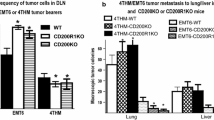Summary
Induction of neoplastic growth of murine stroma cells within the human tumor xenograft was observed after serial passage of CEA and β2-microglobulin producing human colonic SLu tumor xenografts in nu/nu BALB/c mice. Mouse tumors within the human tumor xenografts wre identified using specific immunohistologic staining techniques for mouse histocompatibility marker or human CEA. These mixed tumors could be distinguished from normal human tumor xenografts by a different relationship between development of the tumor marker in the serum and tumor size. We were able to establish transformed murine cells from human xenografts, either induced by SC injection of 1×106 tumor cells of the SLu cell line or by human SLu or mammary carcinoma tissue serially passaged in athymic animals. The established human and murine cell lines were characterized by cytogenetic methods. Transformed murine cells were then continuously passaged in tissue culture. The transformed mouse fibroblasts proved to possess tumorigenicity in nude mice. In the case of SLu-derived mouse tumor cells, tumors also developed in the immunocompetent BALB/c mice using 1×106 to 5×106 tumor cells for SC transplantation.
Similar content being viewed by others
References
Beattie GM, Knowles AF, Jensen FC, Baird SM, Kaplan ND (1982) Induction of sarcomas in athymic mice. Proc Natl Acad Sci 79:3033–3036
Chang EH, Furth ME, Scolnick EM, Lowy DR (1982) Tumorigenic transformation of mammalian cells induced by a normal human gene homologous to the oncogene of Harvey murine sarcoma virus. Nature 297:479–483
Cooper GM, Okenquist S, Silverman L (1980) Transforming activity of DNA of chemically transformed and normal cells. Nature 284:418–421
Ehrlich P (1907) Experimentelle Studien an Mäusetumoren. Z Krebsforsch 5:59–81
Ehrlich P, Apolant H (1905) Beobachtungen über maligne Mäusetumoren. Klin Wochenschr 42:871–874
Goldenberg DM, Pavia RA (1981) Malignant potential of murine stromal cells after transplantation of human tumors into nude mice. Science 212:65–67
Goldenberg DM, Pavia RA (1982) In vivo horizontal oncogenesis by a human tumor in nude mice. Proc Natl Acad Sci 79:2389–2391
Houghton JA, Taylor DM (1978) Maintenance of biological and biochemical characteristics of human colorectal tumours during serial passage in immun-deprived mice. Br J Cancer 37:199–212
huebner RJ, Fisch DC, Djurickovic D, Trimmer RW, Bare AL, Smith GT (1979) Induction of rat sarcoma in rats treated with antithymocyte sera after transplantation of human cancer cells. Proc Natl Acad Sci 76:1793–1976
Krontiris TG, Cooper GM (1981) Transforming activity of human DNAs. Proc Natl Acad Sci 78:1181–1184
Parada LF, Tabin CJ, Shih C, Weinberg RA (1982) Human EJ bladder carcinoma oncogene is homologue of Harvey sarcoma virus ras gene. Natur 297:474–478
Schwarzacher HG (1974) Preparation of metaphase chromosomes. In: Schwarzacher HG, Wolf U (eds) Methods in human cytogenetics. Springer Berlin, pp 71–81
Shih C, Padley LC, Murray M, Weinberg RA (1981) Transforming genes of carcinomas and neuroblastomas introduced into mouse fibroblasts. Nature 290:261–264
Staab HJ, Anderer FA (1981) Correlation of growth of human tumor cell lines with circulating CEA in nude mice. Oncodevel Biol Med 2:P48
Staab HJ, Anderer FA (1982a) Antisera against circulating human tumor-associated antigens prepared with sera of xenografted athymic mice. Tumor Diagnostik 3:29–32
Staab HJ, Anderer FA (1982b) Preferential induction of cell-mediated immunity by chemically modified carcinoembryonic antigen. Int Arch Allergy Appl Immunol 67:78–85
Staab HJ, Anderer FA (1982c) Circulating CEA, a growth parameter in malignant disease. Cancer Prevent Detect (in press)
Staab HJ, Anderer FA (1982d) Growth of human colonic adenocarcinoma and development of serum CEA in athymic mice. I. Strict correlation of tumor size and mass with serum CEA concentration during logarithmic growth. Br J Cancer 46:841–847
Sternberger LA (1979) Immunocytochemistry. John Wiley New York
Tveit KM, Fodstad O, Brogger A, Olsnes S (1980) Human embryonal carcinoma grown in athymic mice in vitro. Cancer 40:949–953
Author information
Authors and Affiliations
Rights and permissions
About this article
Cite this article
Staab, H.J., Heilbronner, H., Schrader, M. et al. In vivo induction of neoplastic growth in nude mouse connective tissue adjacent to xenografted human tumors. J Cancer Res Clin Oncol 106, 27–35 (1983). https://doi.org/10.1007/BF00399894
Received:
Accepted:
Issue Date:
DOI: https://doi.org/10.1007/BF00399894




